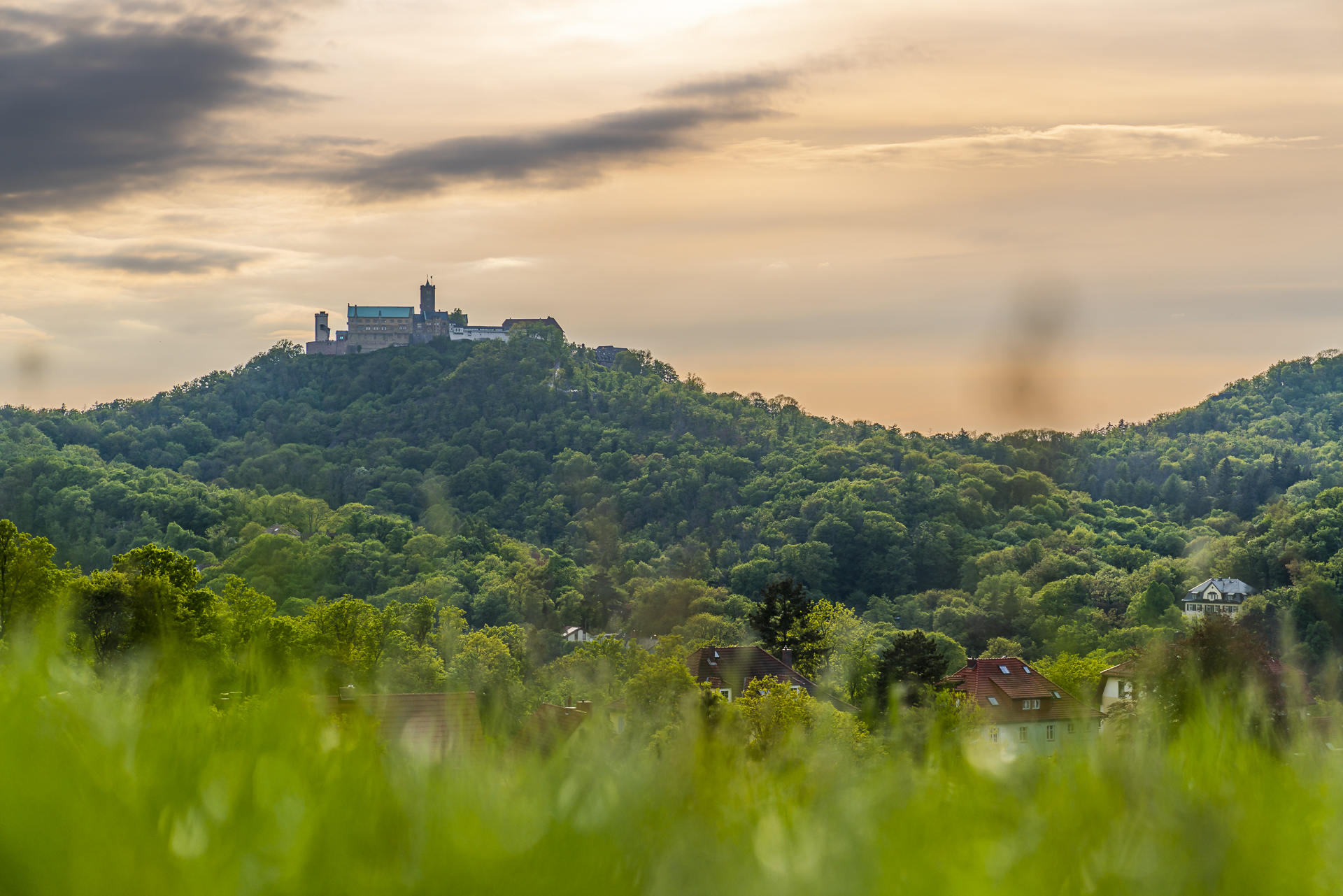
4 days – 4 UNESCO World Heritage Sites: our top tips for your trip to Thuringia
-
Advertising: Contribution in cooperation with the German National Tourist Board e.V.
Thuringia, located in the heart of Germany, scores with a wealth of sights that delight both culture lovers and nature lovers alike. These include the four of Germany’s 51 UNESCO World Heritage Sites. This year, Erfurt’s Jewish heritage could be added to the World Heritage List as number five with the Old Synagogue. But Thuringia also has a lot to offer in other respects: pretty residential towns, almost endless forests and comparatively short distances. The ideal starting point to discover a lot in a short time!
During our short trip over Ascension, we explored some highlights and brought back ten tips for a detour to Thuringia.
1. Set up base camp in the charming Stadthaus Arnstadt
Long-time blog readers may remember that these are not the first enthusiastic lines about Thuringia. In autumn 2013, I was able to visit Erfurt and Weimar as part of a press trip. I can well remember how both cities – each unique in its own way – inspired me from the very first moment. Accordingly, I was looking forward to seeing you again – at the same time, we wanted to take the opportunity to get to know other facets of Thuringia. For this reason, I suggested spending the night in Arnstadt, which is about 20 kilometers south of Erfurt.
The former residential city is closely associated with the Bach family of musicians and has a beautiful old town centre. Walking through the cobblestone streets, you feel like you’ve been transported back to the time when Johann Sebastian Bach worked here as an organist.
In the middle of this idyllic setting stands the Hotel Stadthaus Arnstadt. The eventful history of the ensemble of buildings at the vicarage can be traced back to the 16th century. After the town fire of 1581, the core area of the half-timbered building that stands today was built.
In 2005, Judith Rüber and Jan Kobel discovered the ensemble, which had been vacant for 15 years and had fallen into disrepair. They renovated the buildings, opened the Hotel Stadthaus Arnstadt in 2013 and were awarded the Thuringian Monument Protection Prize a year later. Today, the Hotel Stadthaus Arnstadt is a member of the Association of Holiday Architecture and is definitely a hot accommodation tip for all those who like to spend the night in monuments. The harmonious experience is rounded off with many home-cooked and regionally sourced products for breakfast. In addition, on the ground floor of the adjacent industrial building, which was built at the beginning of the 20th century, is the casual coffee roastery and espresso bar Bohnenstolz. Creaking floorboards, lots of patina and a freshly roasted espresso – what more could you want?
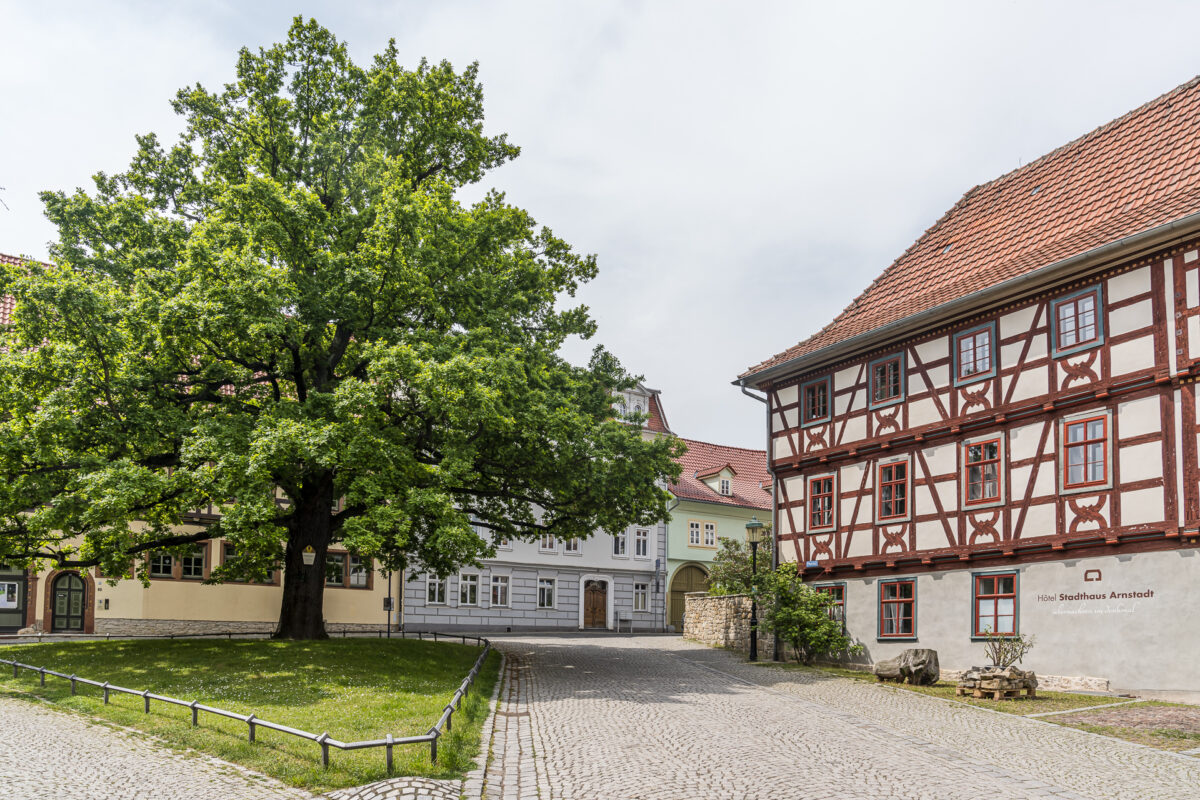
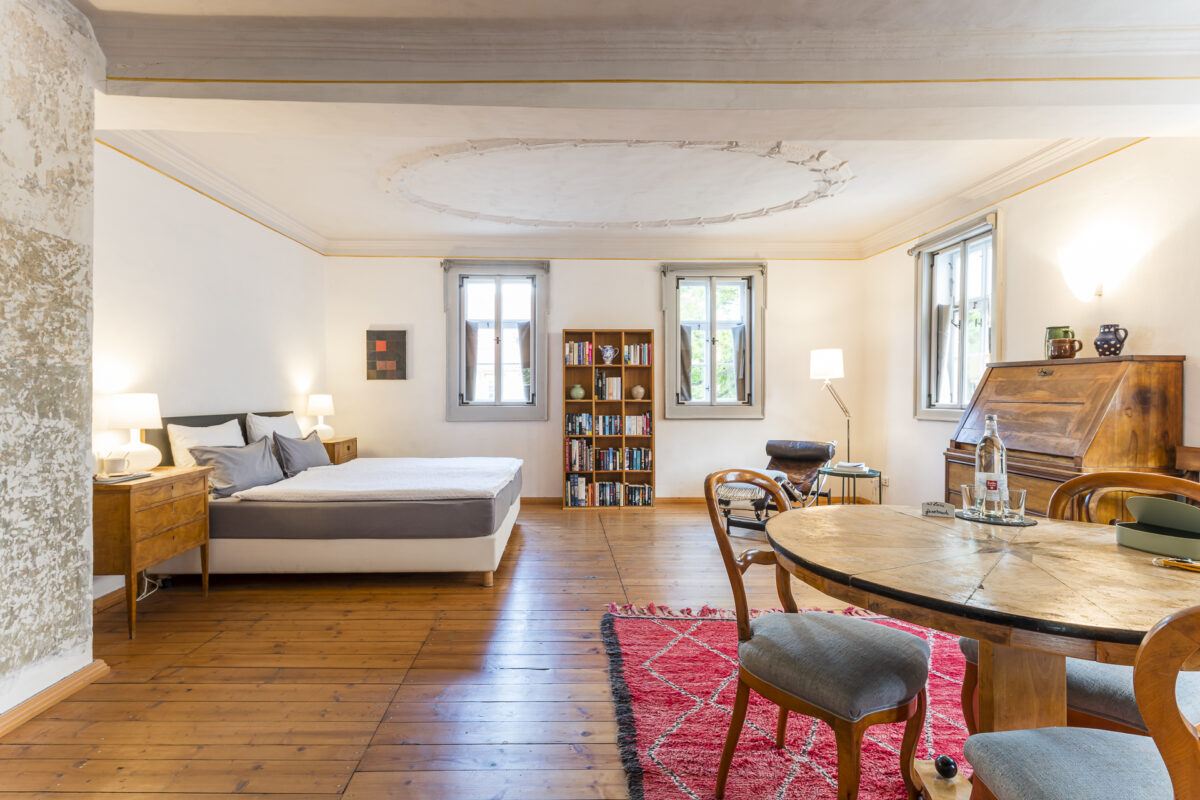
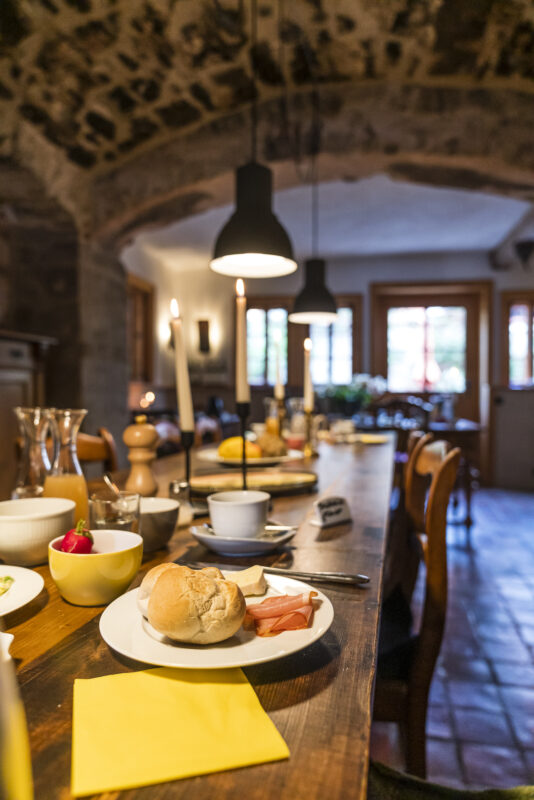
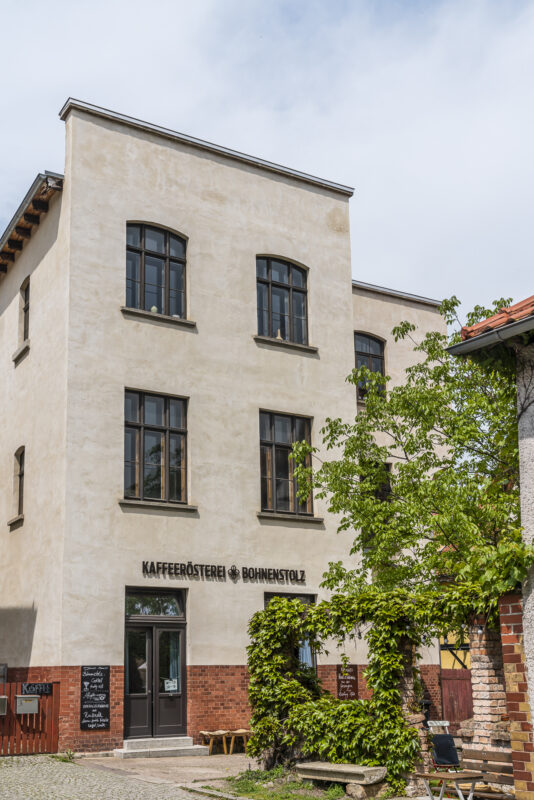
Single room from 109 Euro/night incl. breakfast | Double room from 129 Euro/night incl. breakfast – More information here: stadthaus-arnstadt.de
2. Discover the sights of Arnstadt’s picturesque old town
If you stay at the Stadthaus Arnstadt, you will benefit from the best starting point for an exploration tour through the historic city centre. Worth seeing is the castle museum with its magnificent baroque rooms, which is housed in the former residential palace of the Counts of Schwarzenburg. A magnet for visitors here is the doll town “Mon plaisir”, which is unique in the world and can be traced back to the passion for collecting of Princess Auguste Dorothea of Schwarzenburg-Arnstadt. Another highlight is the Bach Church, also known as the Arnstadt Bach Church. It is closely associated with the famous composer Johann Sebastian Bach, who worked here as an organist.
Right next to the Bach Church is the picturesque market square with the imposing town hall – and if you follow the cobblestone alleys uphill through the Neutor tower towards the Alteburg tower, you will be rewarded with beautiful panoramic views over Arnstadt.
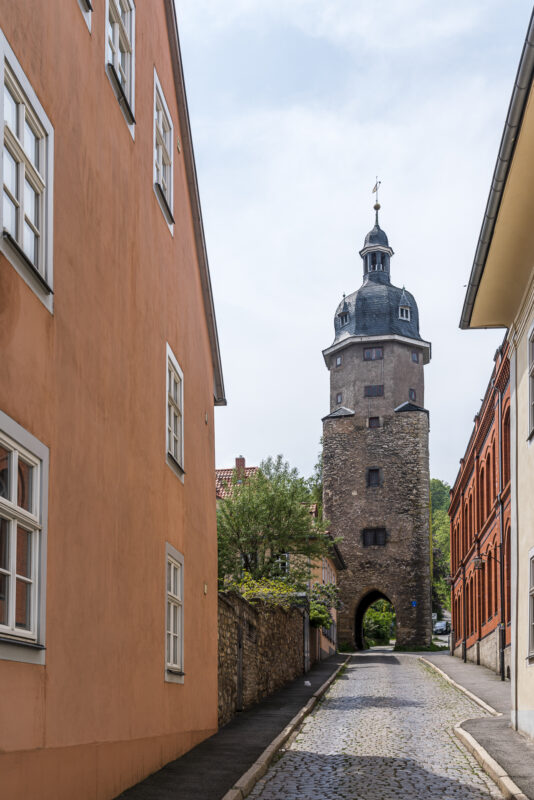
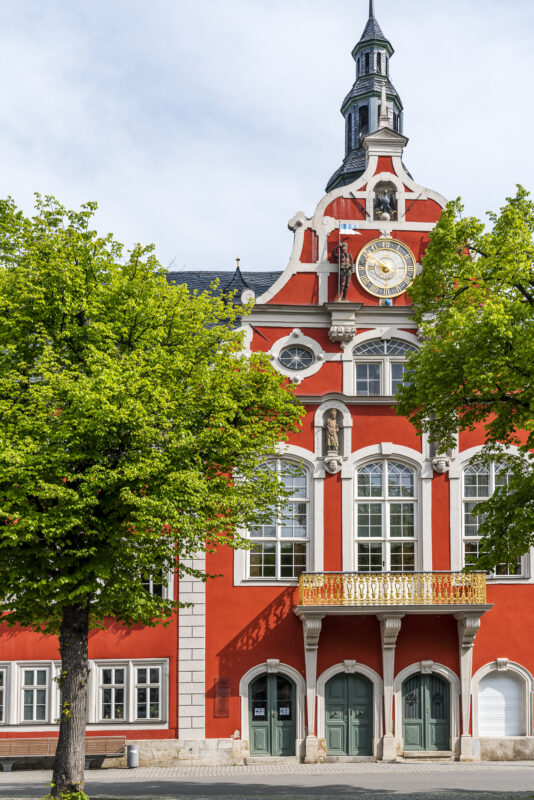
My tip: In Arnstadt, regular public city tours are offered. This is an ideal opportunity to benefit from insider knowledge and listen to exciting anecdotes from the city’s more than 1,300-year history. Cost for adults: from 7 euros | More info: Weekly offer
3. Stroll over the Erfurt Krämerbrücke
Our first excursion took us from Arnstadt to the well-known Erfurt. I really liked the city on my first visit in 2013 and the second visit confirmed the positive memories throughout. Of course, our first sightseeing stop was also the landmark of Erfurt – the picturesque Krämerbrücke. The first exploratory mention of the bridge can be found in writings from the 12th century. From this it can also be deduced that Erfurt was on the route of the so-called Via Regia – an important trade axis running in a west-east direction. It was built in its present form in the 15th century. Today, 32 of the once 62 half-timbered buildings have been preserved and restored. The Krämerbrücke is thus considered to be the longest continuously built bridge north of the Alps (the counterpart south of the Alps would be the Ponte Vecchio in Florence).
The most photogenic is the Krämerbrücke from the northern side (Gotthardstrasse). With a bit of luck, the tower of the Ägidienkirche may also be open, from where you get a great bird’s view of the Krämerbrücke (unfortunately the tower was closed during our visit).
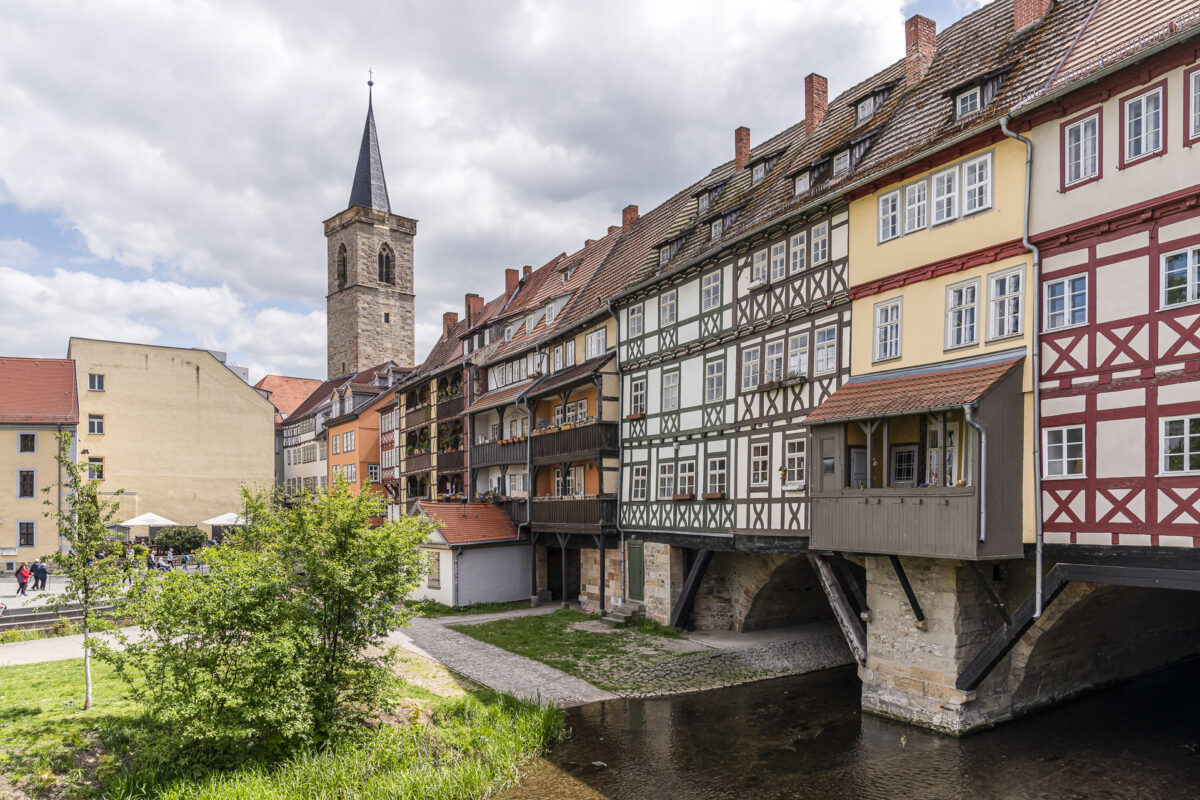
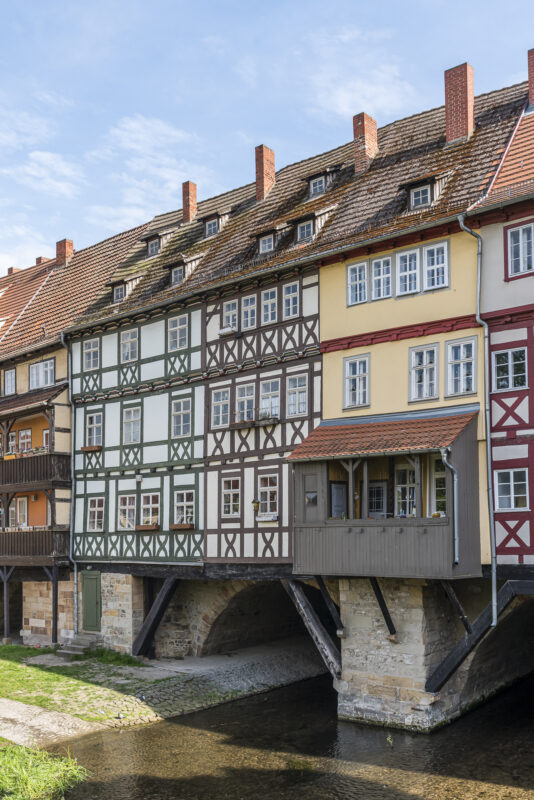
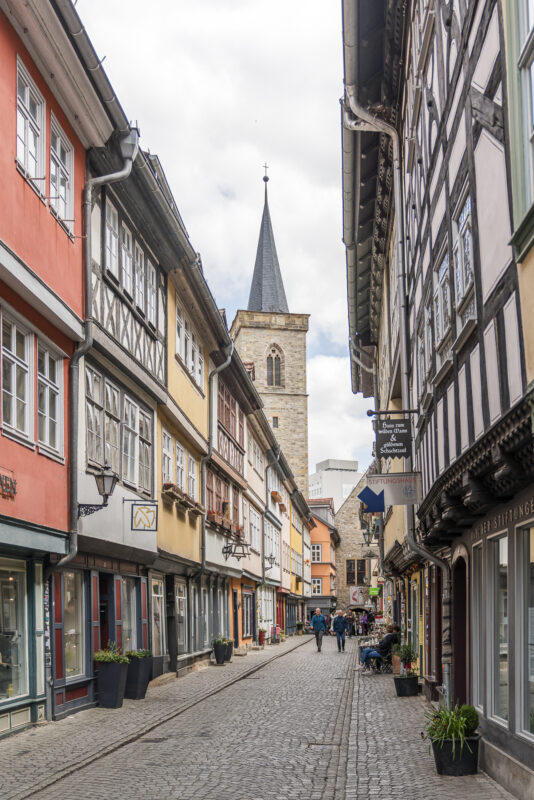
More background information about the Krämerbrücke can be found in a permanent exhibition in the House of Foundations. Here you also have the opportunity to visit a bridge house from the inside.
A popular culinary stop on the Krämerbrücke is the Goldhelm ice cream parlour – the homemade ice cream creations taste fantastic. And for all those whose stomachs are rumbling at this point, I can recommend a stop at the Platzhirsch restaurant on the Wenigmarkt (directly at the eastern entrance to the Krämerbrücke). Here you will also find some classic Thuringian specialties on the menu.

4. Learn more about Erfurt’s Jewish-medieval heritage
In the winding alleys of Erfurt’s old town, various testimonies of medieval Jewish culture can be found. In connection with the “rediscovery” of the Old Synagogue on Waagegasse, the history was reappraised and other associated historical sites (such as the medieval mikveh) were also discovered. Today, there are various information steles scattered throughout the old town, on which the buildings belonging to the Jewish-medieval heritage are located. The decision on whether the Jewish-medieval heritage of Erfurt will be included on the list of UNESCO World Heritage Sites could be made before the end of this year.
Regardless, I can highly recommend a visit to the Old Synagogue. Inside there is a museum where you can learn more about the importance of the Jewish community and its everyday life, and also visit the so-called “Erfurt Treasure”.
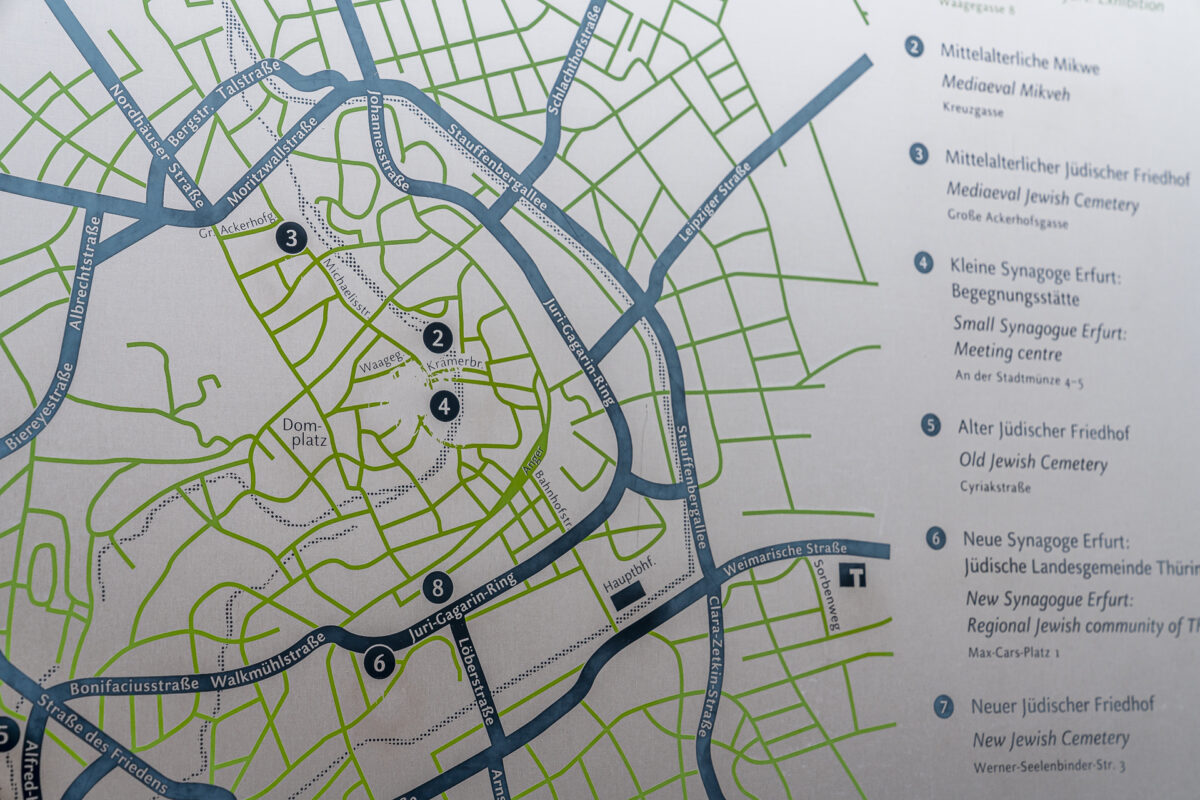
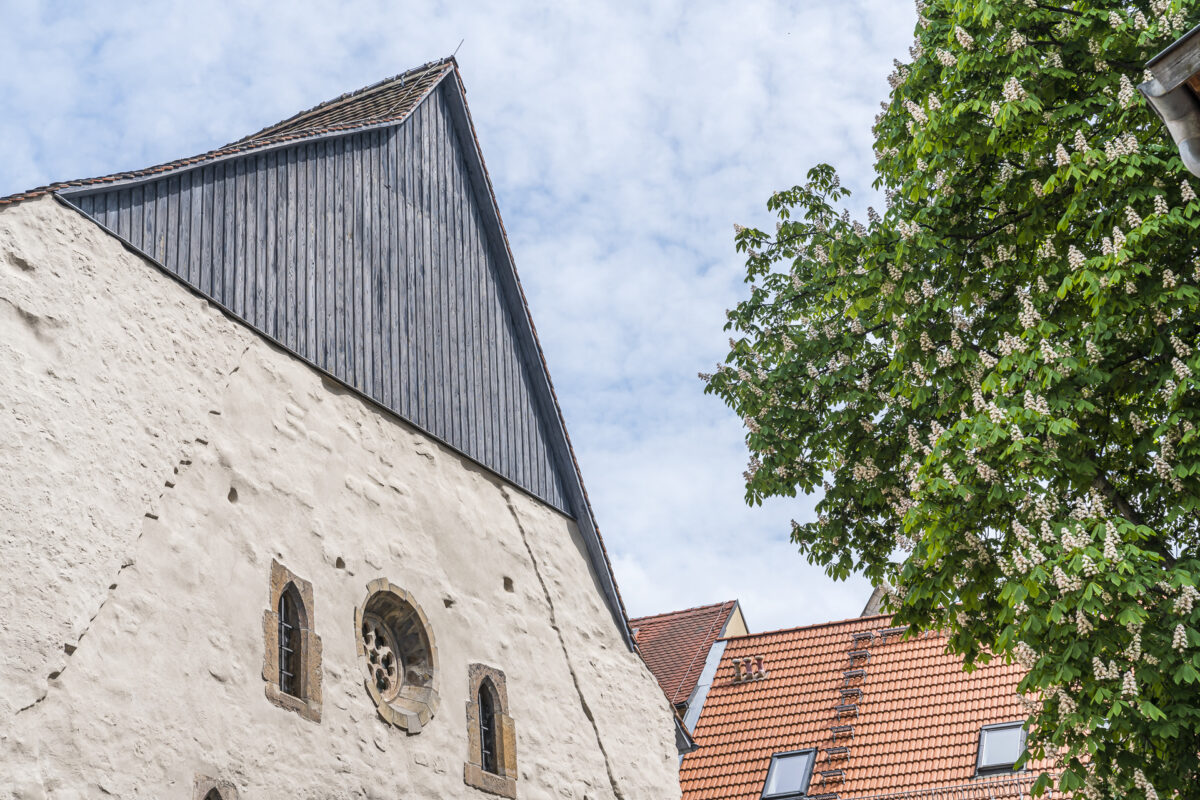
Opening hours Tuesday to Sunday 10:00 a.m. – 6:00 p.m. | Admission adults 8 Euro
On Saturday at 10:15 a.m. there is
a public guided tour of the museum Note: Photography is not allowed in the museum | Click here for the visitor information5. Admire Erfurt’s city scenery from the Petersberg
In contrast to the Krämerbrücke and the other alleys of the old town, the Petersberg has undergone a veritable metamorphosis since my last visit to Erfurt. The citadel, which was laid out in a star shape high above the old town, was already one of the most visited sights in Erfurt at that time, but it seemed rather barren and was also not ideally connected to the cathedral square. In the course of the Federal Horticultural Show (Buga) 2021, the Petersberg was significantly upgraded as an excursion destination and urban recreation area.
The plateau of the Petersberg is now easily accessible via an elevator. Various panoramic paths have been implemented and both the Romanesque St. Peter’s Church and the Commandant’s House have been used for newly designed exhibitions. Of particular interest is the interactive exhibition on the historical development of the Petersberg. But you can also spend a few hours on the Petersberg.
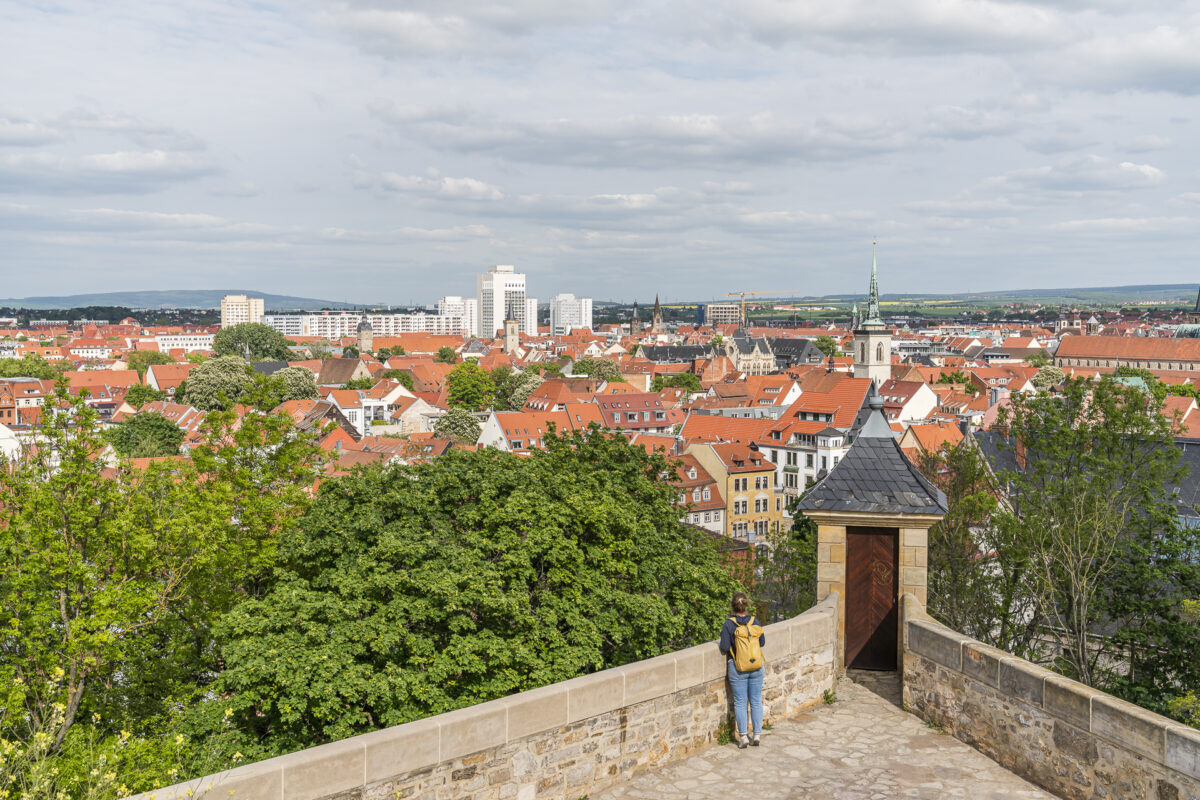
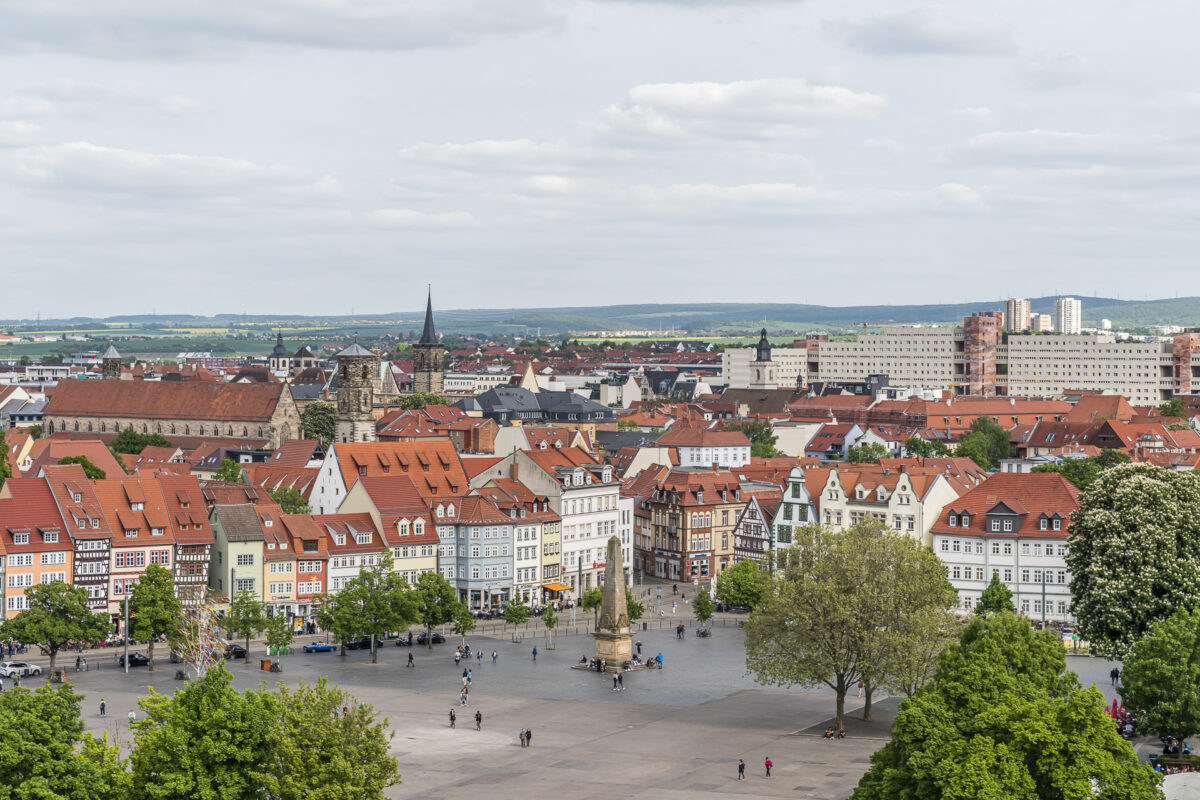
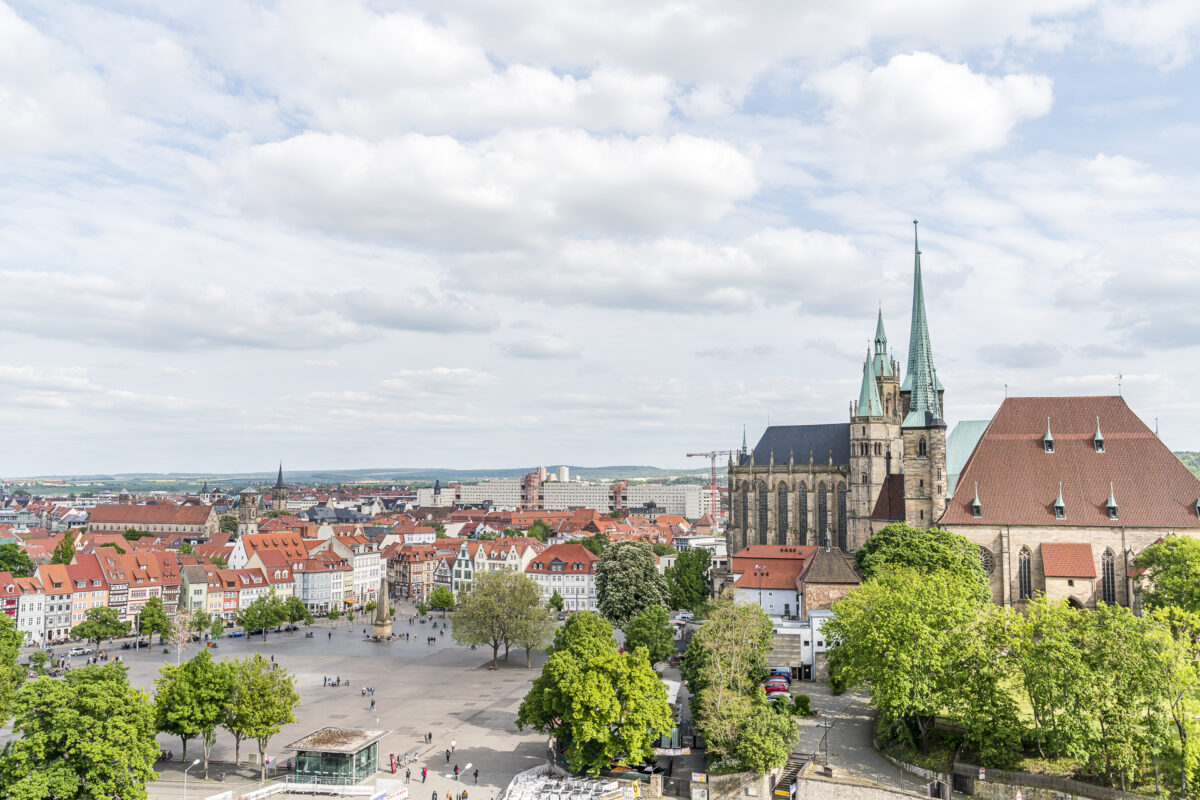
More information about all the activities on the Petersberg can be found on the website of the Petersberg Citadel.
6. Immerse yourself in Weimar Classicism
While Erfurt, to my surprise, still swims under the radar when it comes to German city break destinations, Weimar is known to many. The numerous UNESCO monuments in the Weimar city area certainly contribute to this. A total of eleven properties are part of the UNESCO World Heritage Site “Weimar Classicism”.
Weimar Classicism covers the period from 1786 to 1832 and is directly related to Goethe, Schiller, Wieland and Herder, who shaped the city’s cultural life during this period. If you want to explore the sights of Weimar Classicism on your own, it’s best to download the Weimar+ app to your smartphone in advance. The app not only provides a quick overview by means of an interactive map, but also offers exciting audio tours as well as other background information prepared in the form of digital guides. For example, we used the app when visiting the Rococo Hall of the Duchess Anna Amalia Library.
The city centre of Weimar can be easily explored on foot. My tip: Start your “Classic Tour” at the Weimar City Palace (currently being renovated), walk from there through the park on the Ilm to the Anna Amalia Library (Attention: pre-reserve visiting time slots via the ticket shop!) .
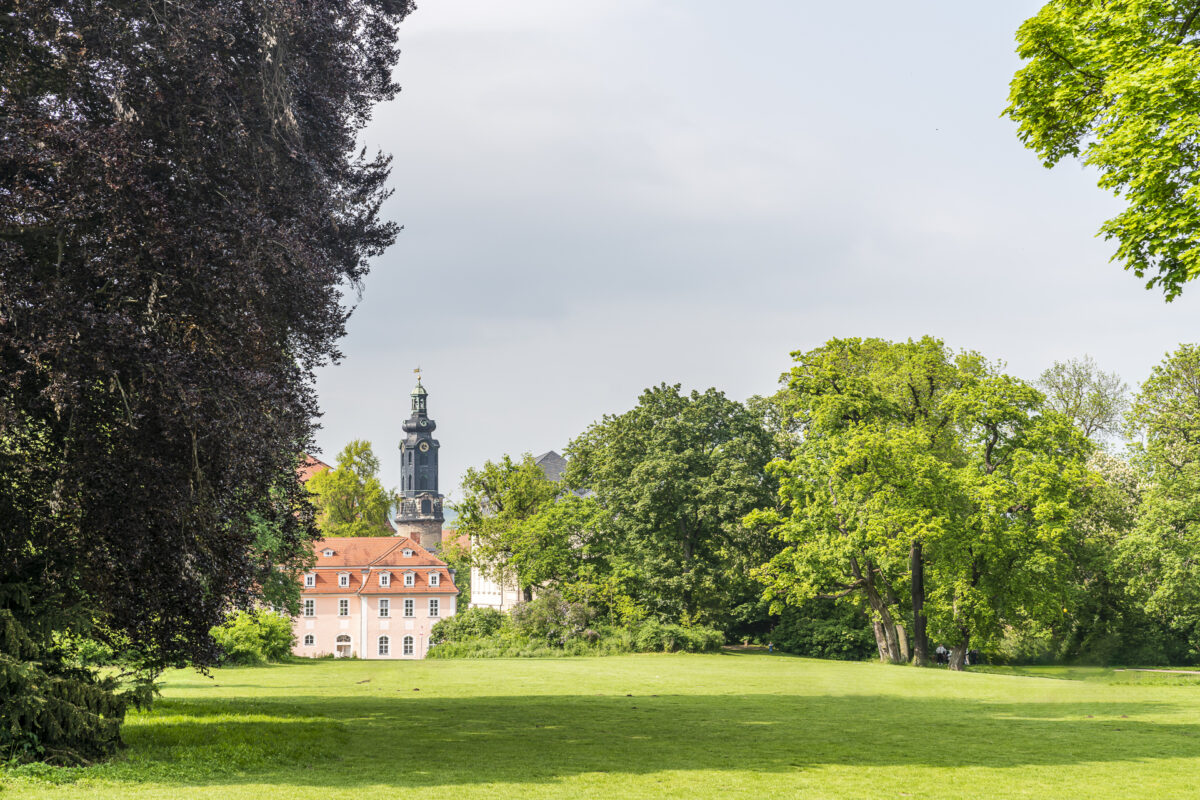
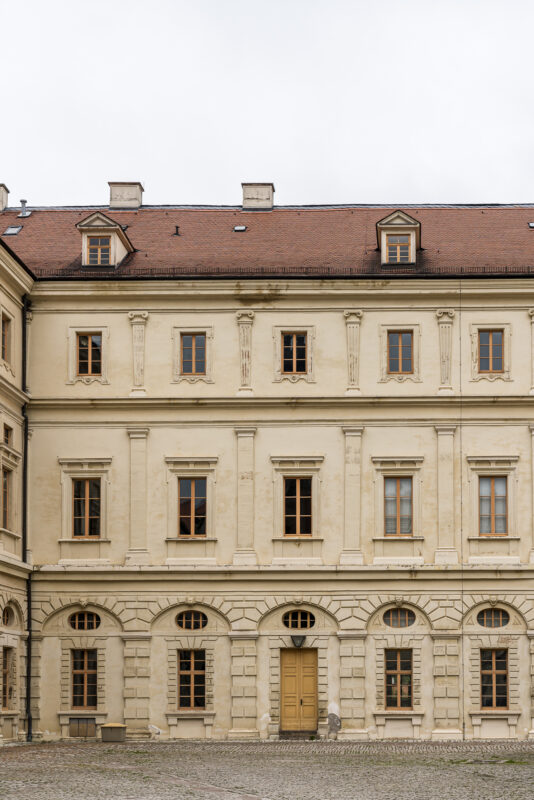
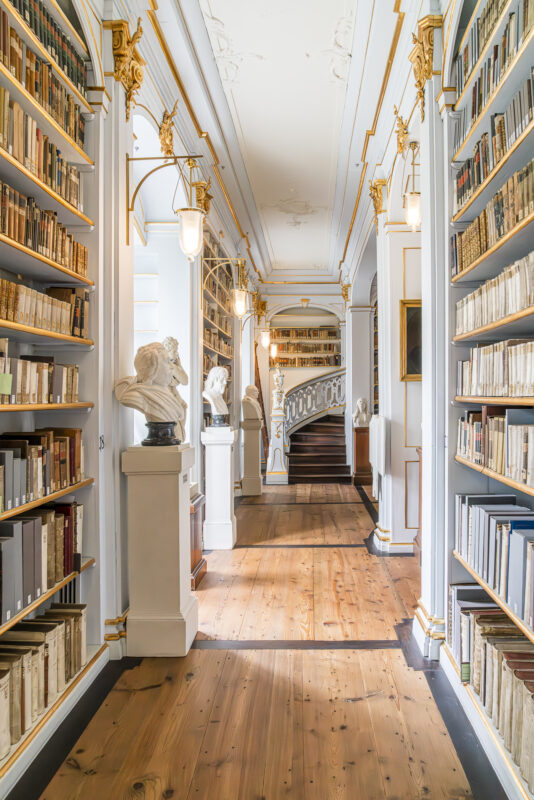
Then follow the pretty soap alley to Goethe’s house. Afterwards you will control Schiller’s residence, make an arch to the Wittumspalais and end your tour on the beautifully framed market square. There is not only the tourist information, but also the recommendable restaurant zum Schwarzer Bären, which convinced us with its seasonal market cuisine. When the weather is nice or if you’re in the mood for coffee and cake, the Lieblingsgarten café, which opened this spring, is also a top option for refreshments. The team has conjured up a very fine aperitif plate for us.
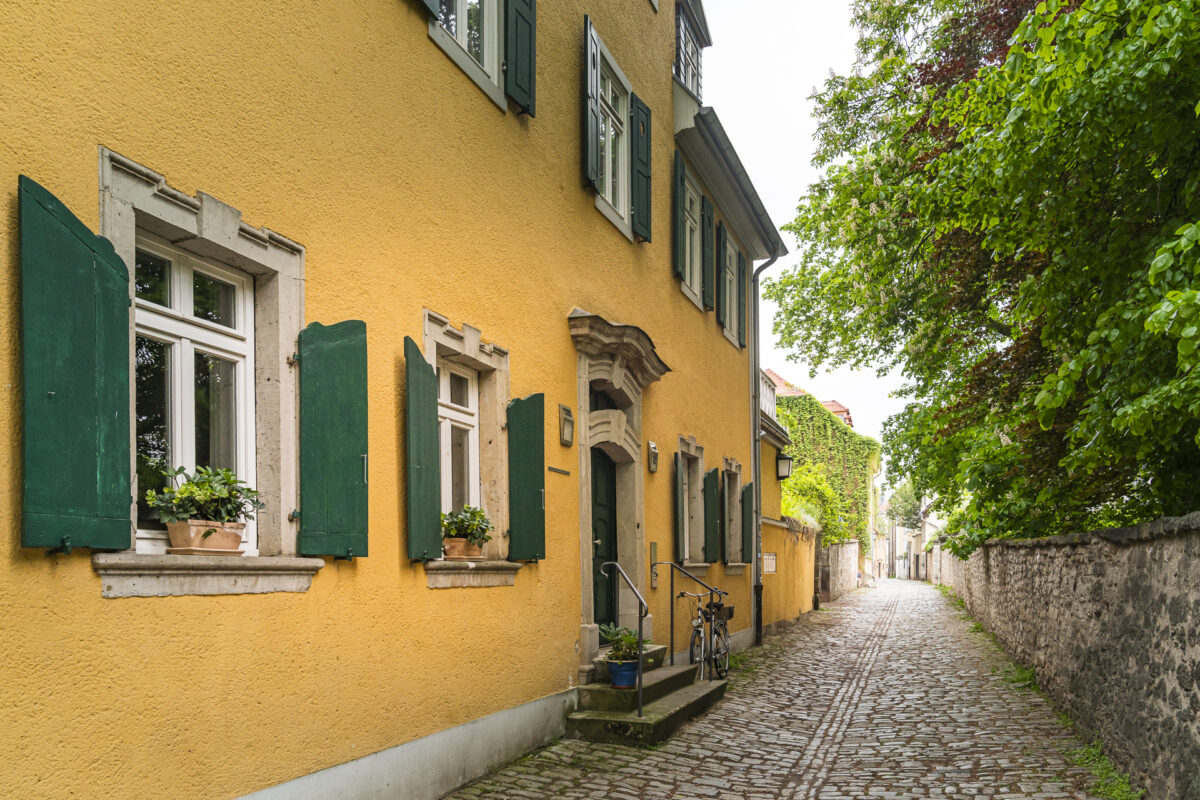
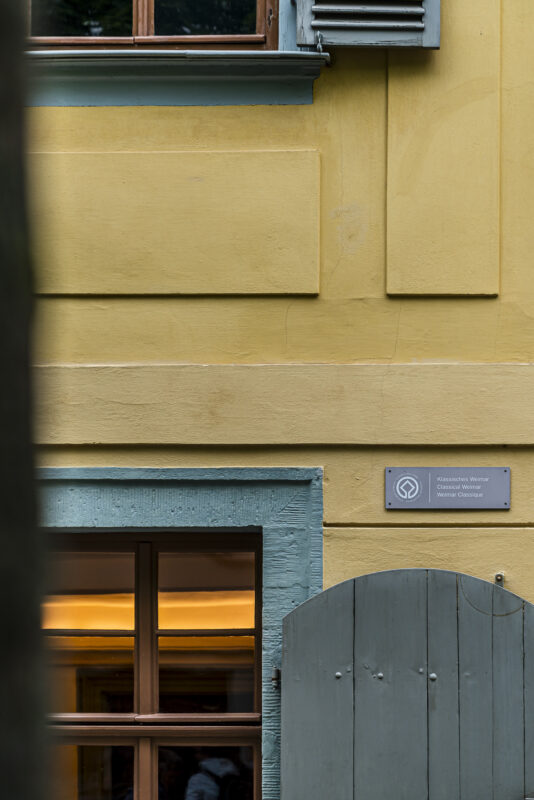
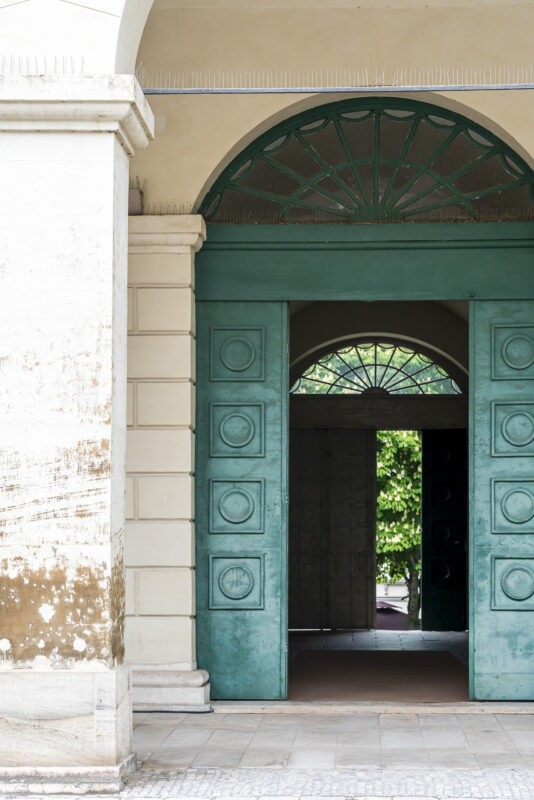
Three of the eleven properties – the Belvedere Palace Park with its palace and orangery, Tierfurt Palace and Ettersburg Castle – are located within walking distance of the city centre. To get to the Belvedere Palace Park, you can either take an extended, one-hour walk through the park on the Ilm (and beyond), or take bus no. 1 from Weimar, Wielandplatz in about 15 minutes. The detour is particularly worthwhile when the weather is nice.
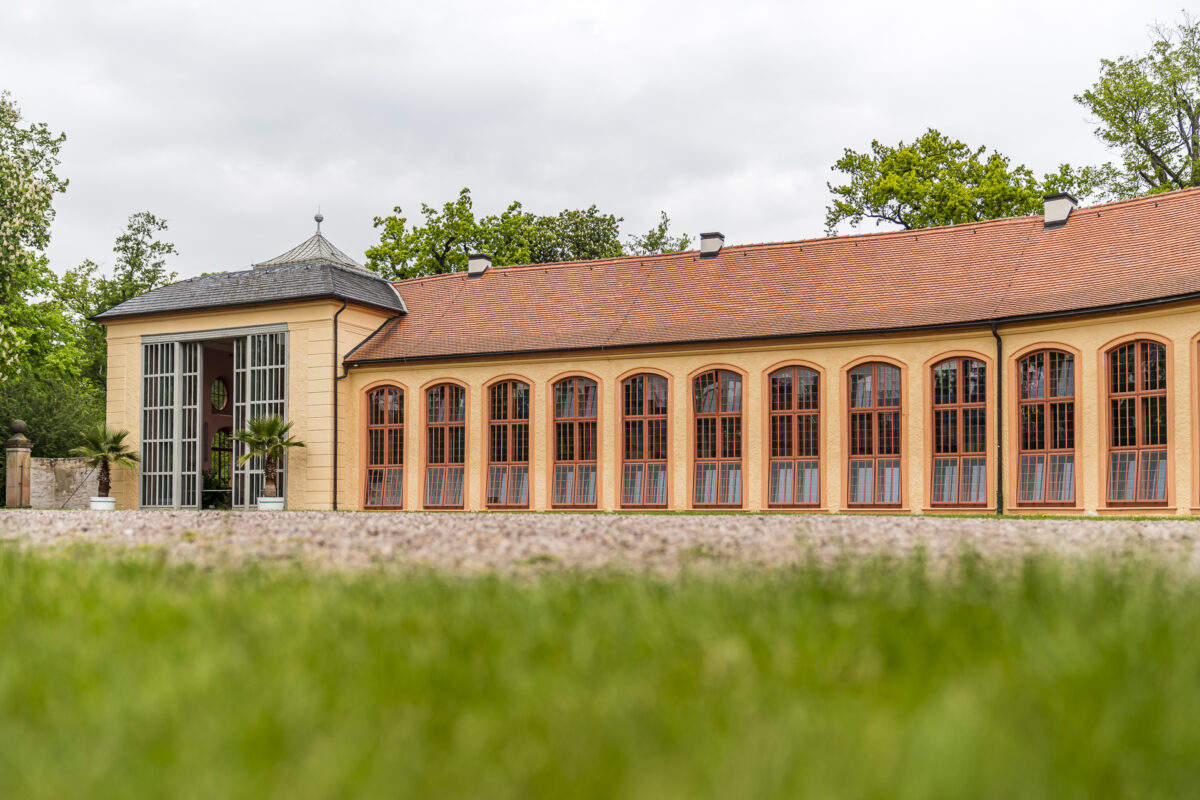
7. Learn more about the history of the Bauhaus
Another Weimar property that is classified as a World Heritage Site is Haus Am Horn – a model house of the Bauhaus Weimar. You can also visit this individually, or you can join the regular public Bauhaus walks. The walks are led by students of the Bauhaus University and also offer exciting background information about the founding site of the Bauhaus. In the first part of the tour, you get an insight into the Van de Velde building, which was built in 1905/1906, and the main building, also built according to the plans of Henry van de Velde in 1911, with the director’s room designed by Walter Gropius.
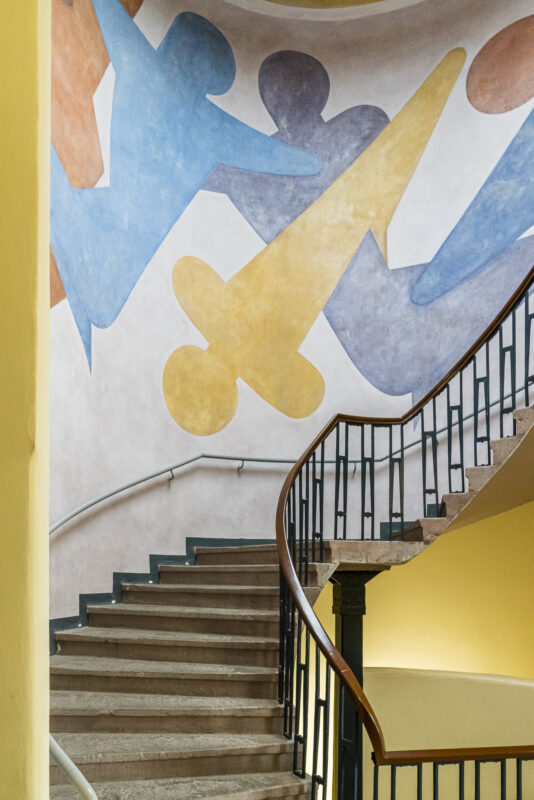
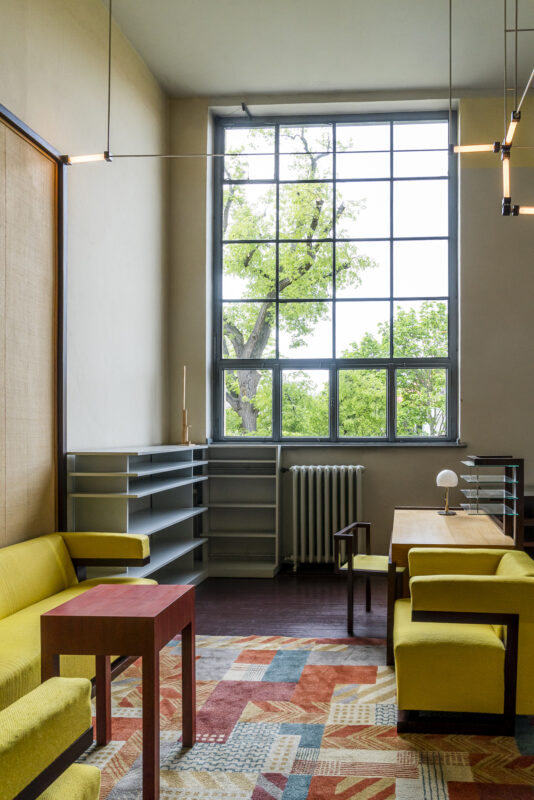
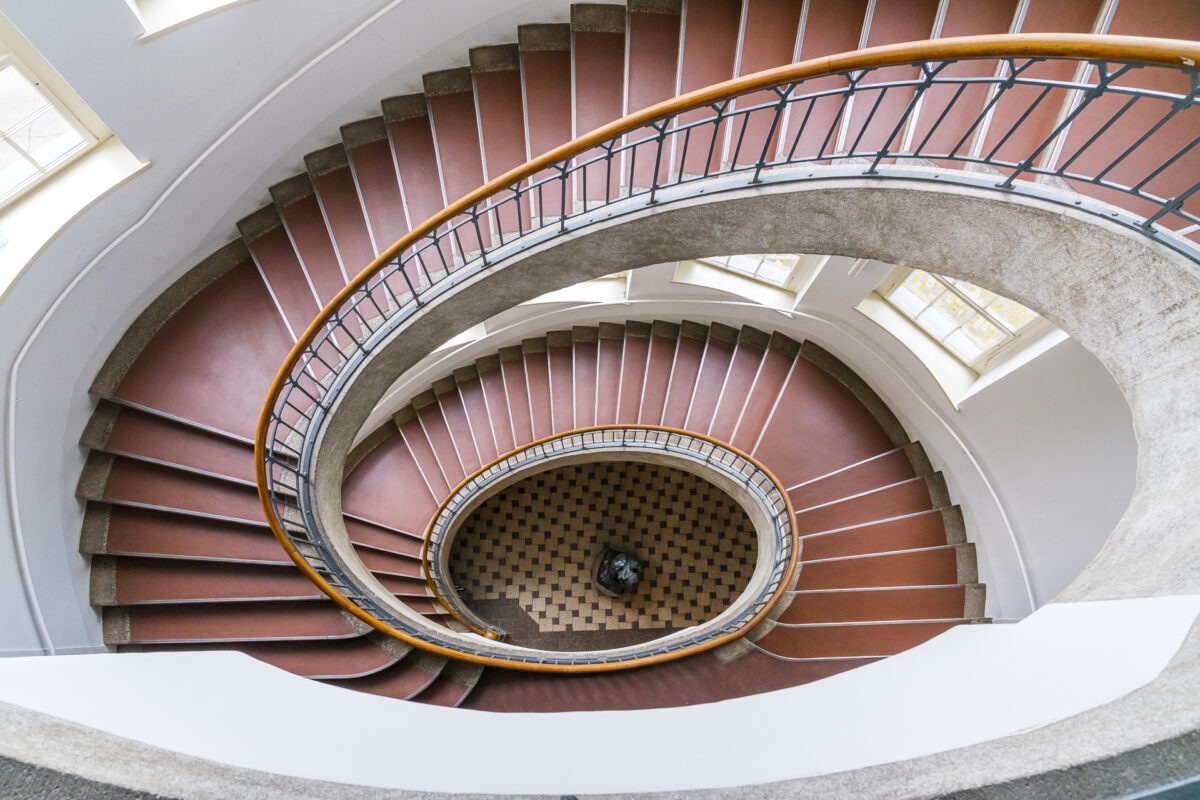
On the occasion of the 100th anniversary of the State Bauhaus, which was founded in Weimar in 1919, the new Bauhaus Museum Weimar opened in 2019. This makes Weimar one attraction richer and I have a good reason for a third detour to the city. Our day in Weimar was already so “packed” with sights that it was unfortunately only enough for a short look from the outside.

The public Bauhaus walk will take place from 21 April to 1 November on Wednesdays, Fridays and Saturdays at 2:00 pm. Participation in the short walk costs 8 euros, participation in the big walk (incl. Haus am Horn) costs 11 (euros). Further information can be found here: Uni Weimar Bauhaus Walk
8. Visit the almost 1,000-year-old Wartburg Castle
One of Thuringia’s landmarks with Germany-wide appeal is the Wartburg Castle. It sits enthroned at the northwestern end of the Thuringian Forest, high above the city of Eisenach. In 1999, it was the first and so far only castle in Germany to be added to the list of UNESCO World Heritage Sites. An excellent view of the impressive scenery of this almost 1000-year-old castle can be obtained from the panorama trail on the opposite side of Eisenach (head for the fraternity car park recorded in Google Maps and then follow the path on foot for about 250 metres in a south-easterly direction).
The following information is good to know when planning a visit to Wartburg Castle:
As a listed hilltop castle, the Wartburg is not barrier-free. From the car park or the bus stop, it is an approx. ten-minute walk up stairs to the fortress.
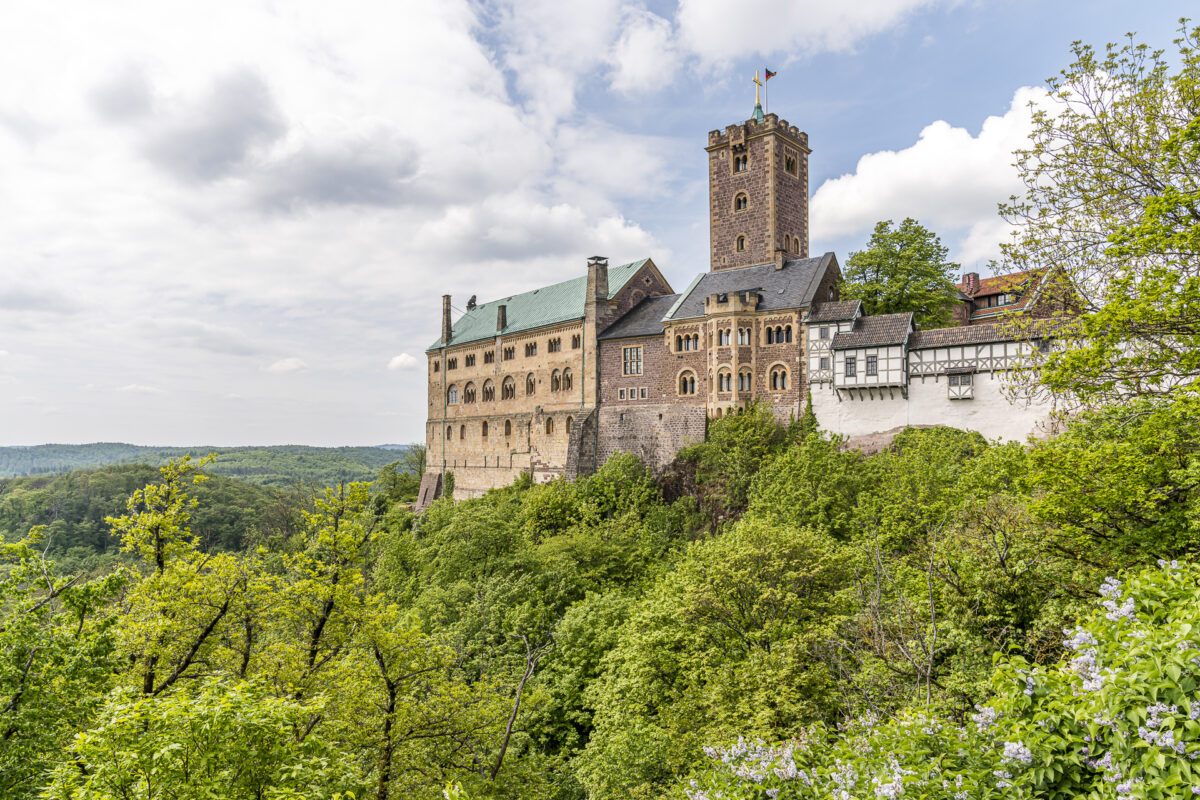
The interiors of the Wartburg Castle can only be visited as part of guided tours daily from 9:00 a.m. to 3:00 p.m. (the guided tours start at regular intervals. Pre-booking a time slot is recommended, but not mandatory). From 3:20 p.m. to 5:00 p.m., the rooms are open for individual viewings. This allows you to adjust the visiting time to your preferred type of visit.
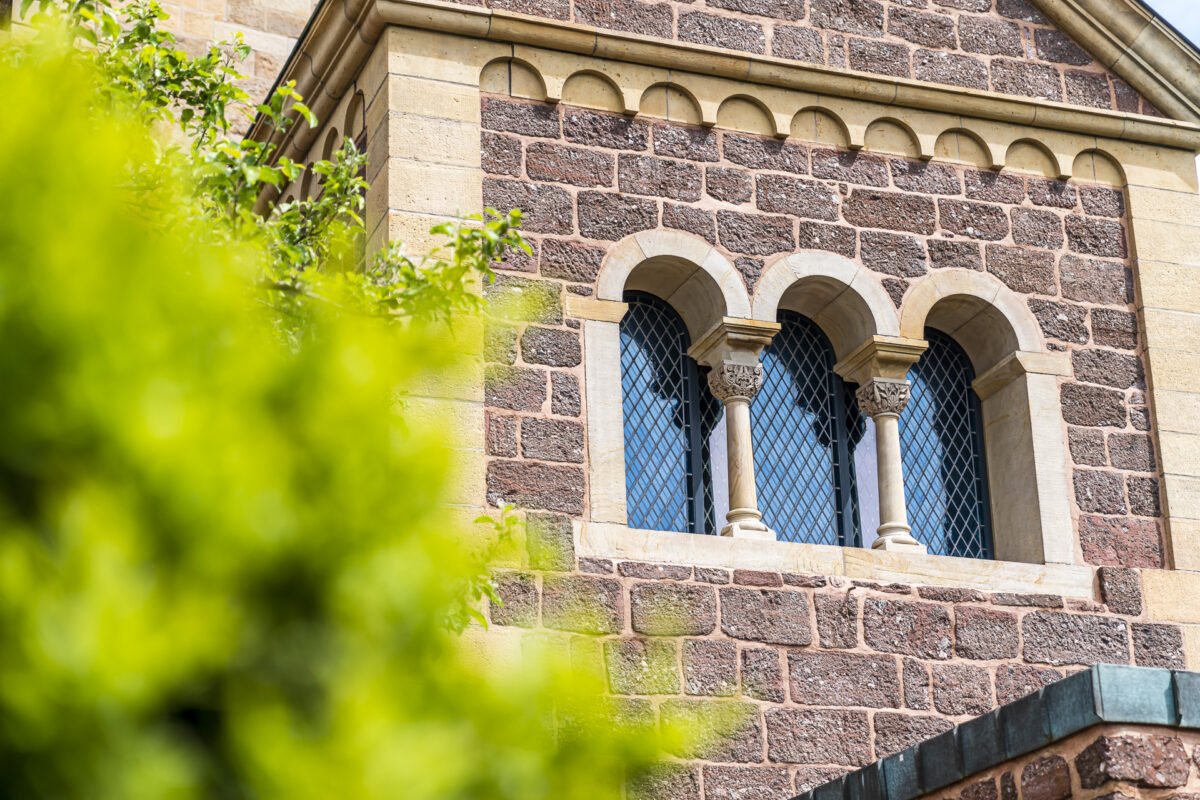
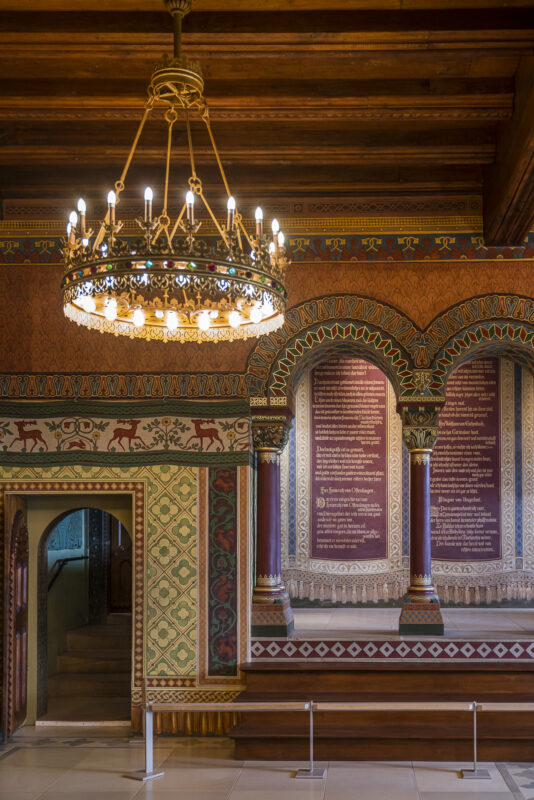
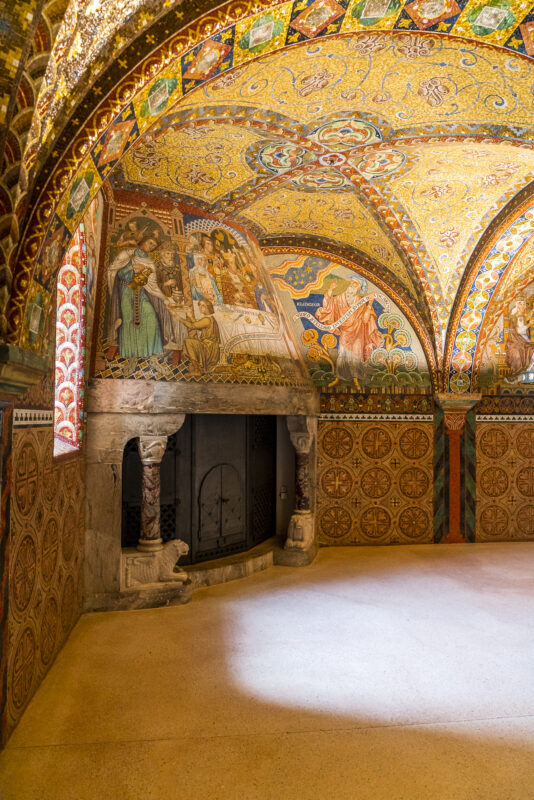
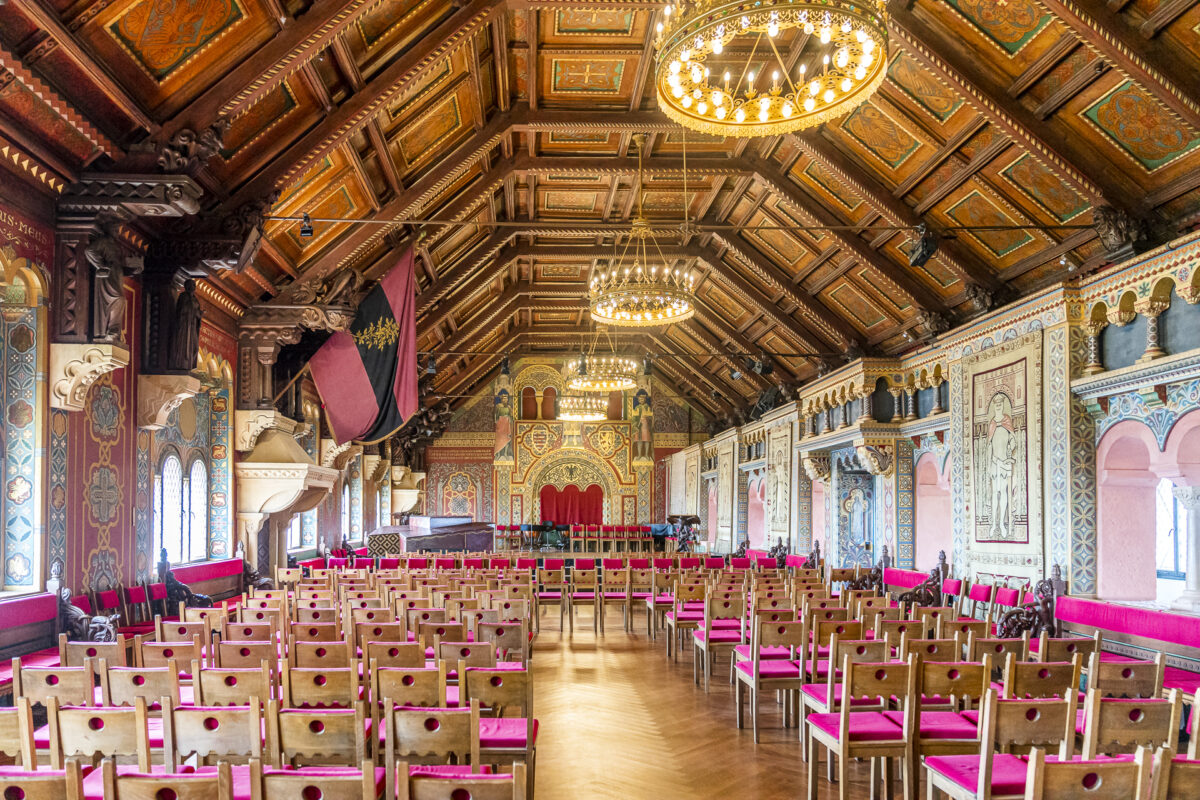
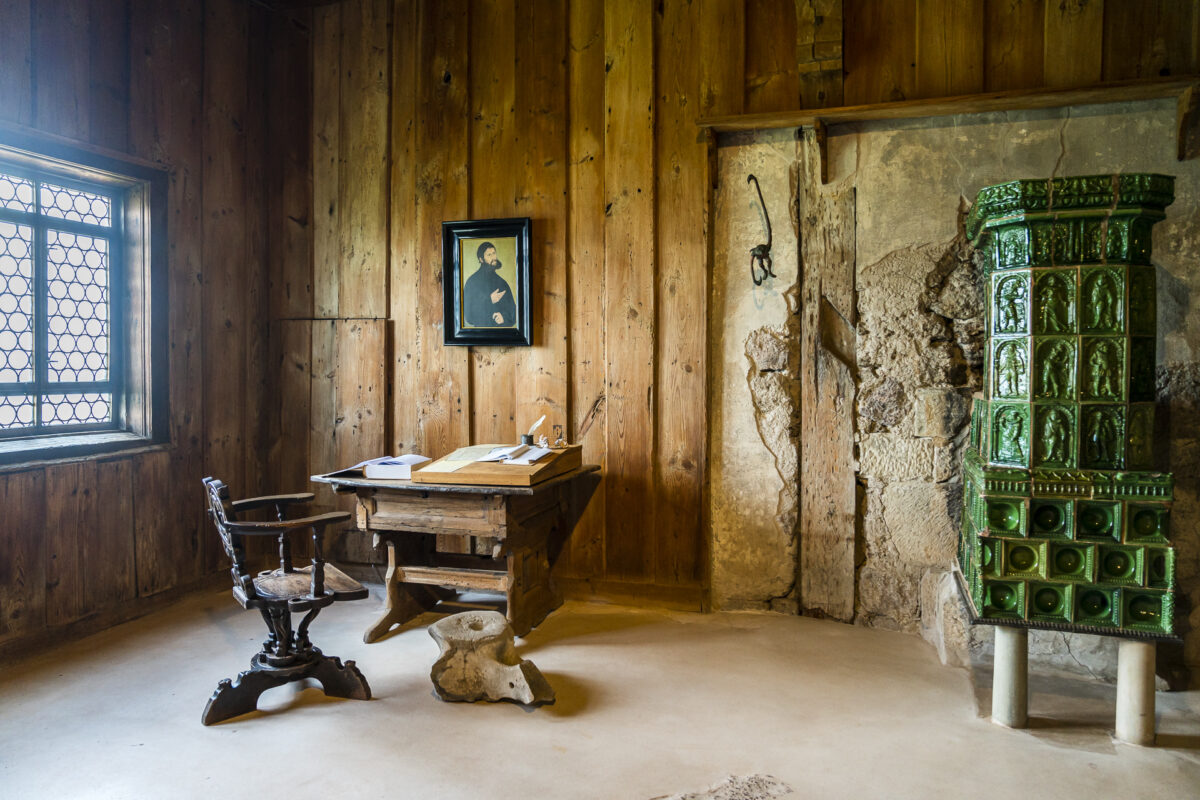
My highlight was the view of the Thuringian Forest from the south tower. Green as far as the eye can see! But I will also have fond memories of the entertaining guided tour through the magnificent rooms and the view into the legendary Lutherstube.
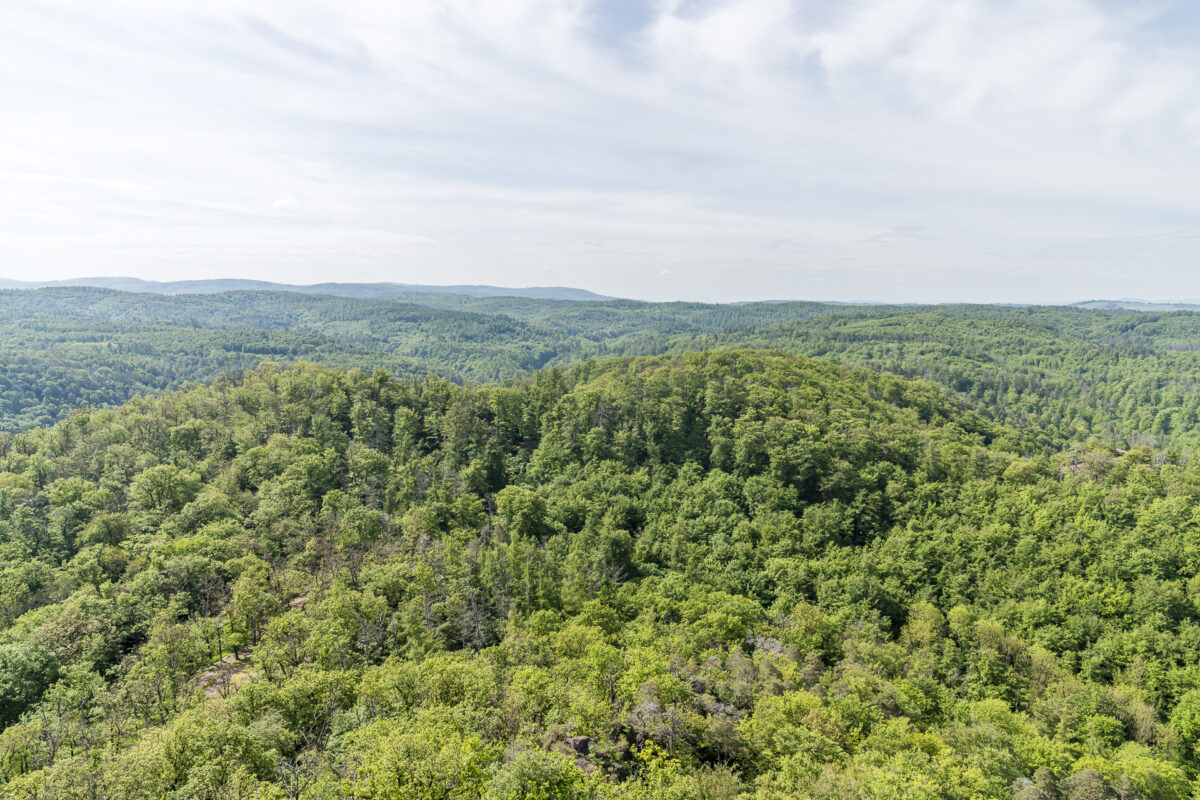
Admission adults 12 euros, photo permit 2 euros, admission south tower 1 euro | Further information: Wartburg.de
9. Marvel at the green canopy of the Hainich from the treetop path
Our last detour of this Thuringia trip takes us from the Wartburg almost 30 kilometers further to the northeast. This is where the Hainich National Park Centre Thiemsburg is located. Established in 1997, the national park was added to the UNESCO World Heritage Site of Primeval Beech Forests and Ancient Beech Forests of the Carpathians and other regions of Europe at the end of 2011.
The local treetop walk was opened in 2005 as Germany’s second treetop walk and has been a popular destination ever since. The combination of a visit to the very informative National Park Centre and an entertaining walk along the treetop path is worthwhile for families with children or for anyone else who wants to get an insight or overview of the green canopy of the Hainich in a short time.
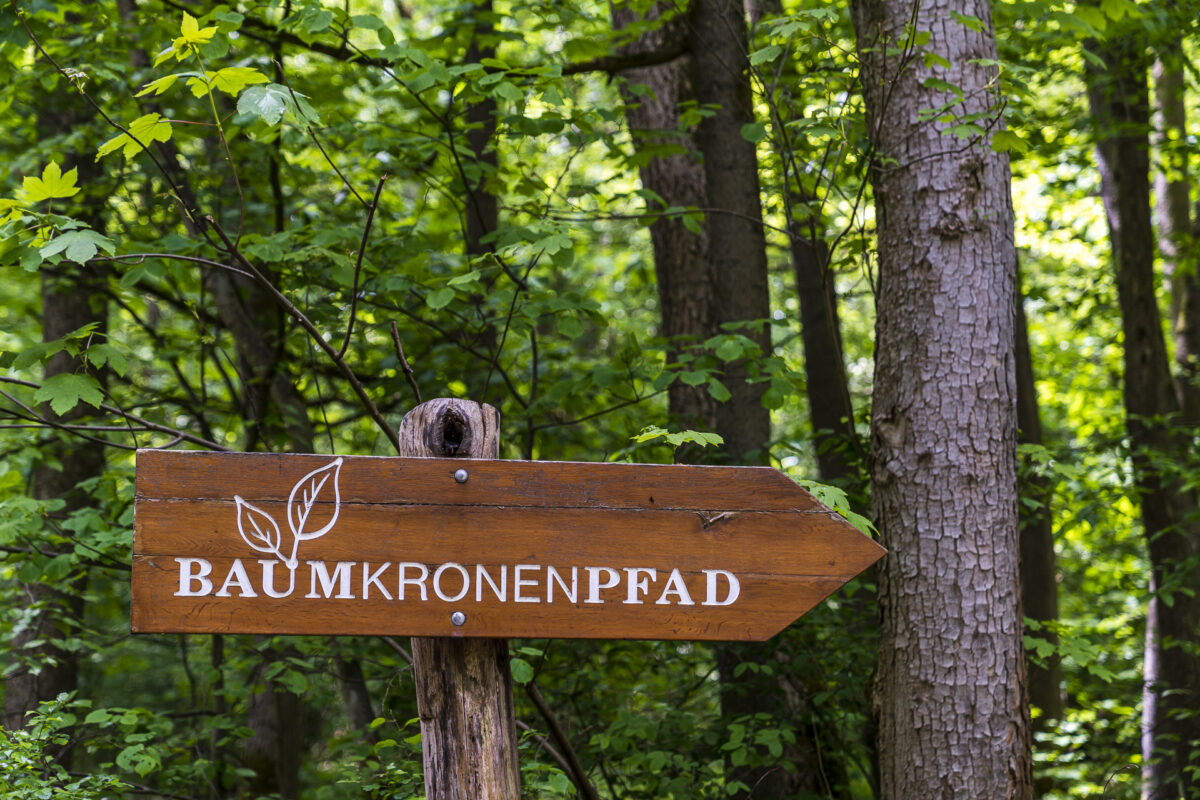
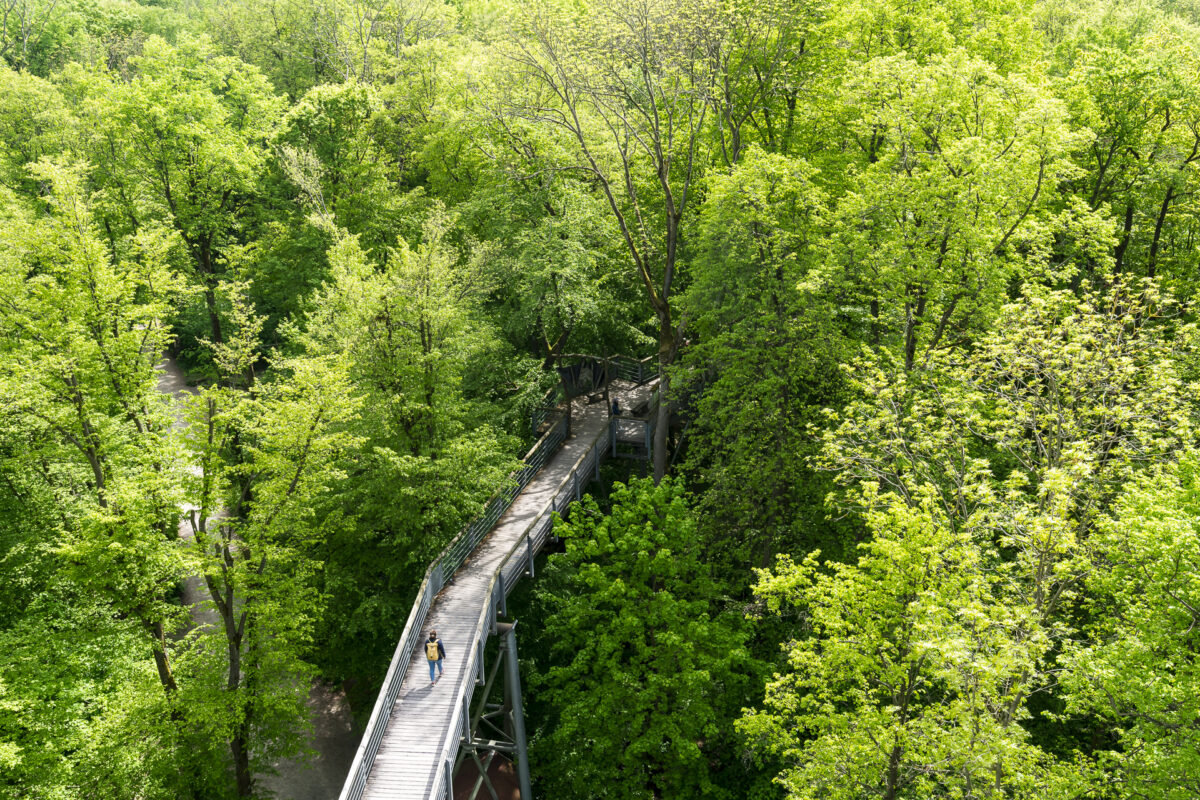
The combined ticket Erlebniswelten (National Park Centre) and Treetop Walk costs 12 euros for adults | Further information: Baumkronen-pfad.de
10. Take a hike through the Hainich National Park
If you have a little more time (at least half a day), I would also recommend a hike on one of the numerous signposted hiking trails. There are a total of 20 circular hiking trails of different lengths to choose from. An overview can be found on the website of the Hainich National Park.
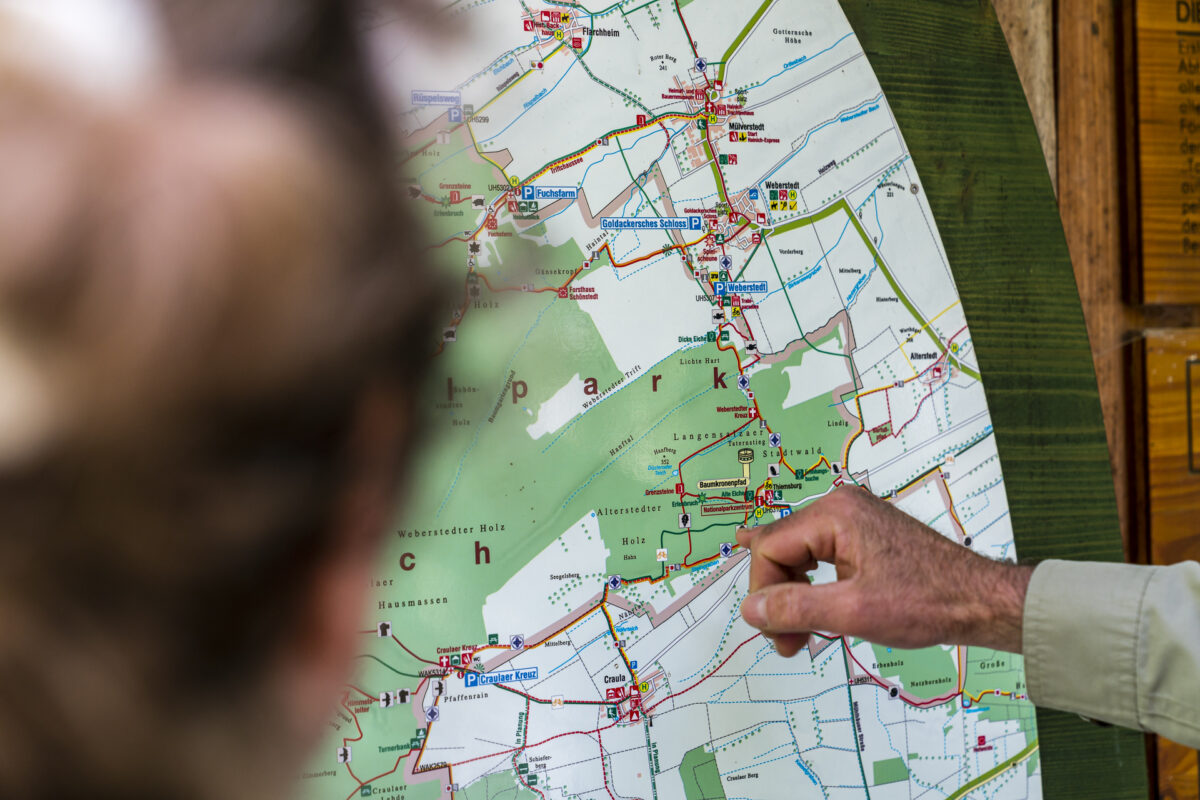
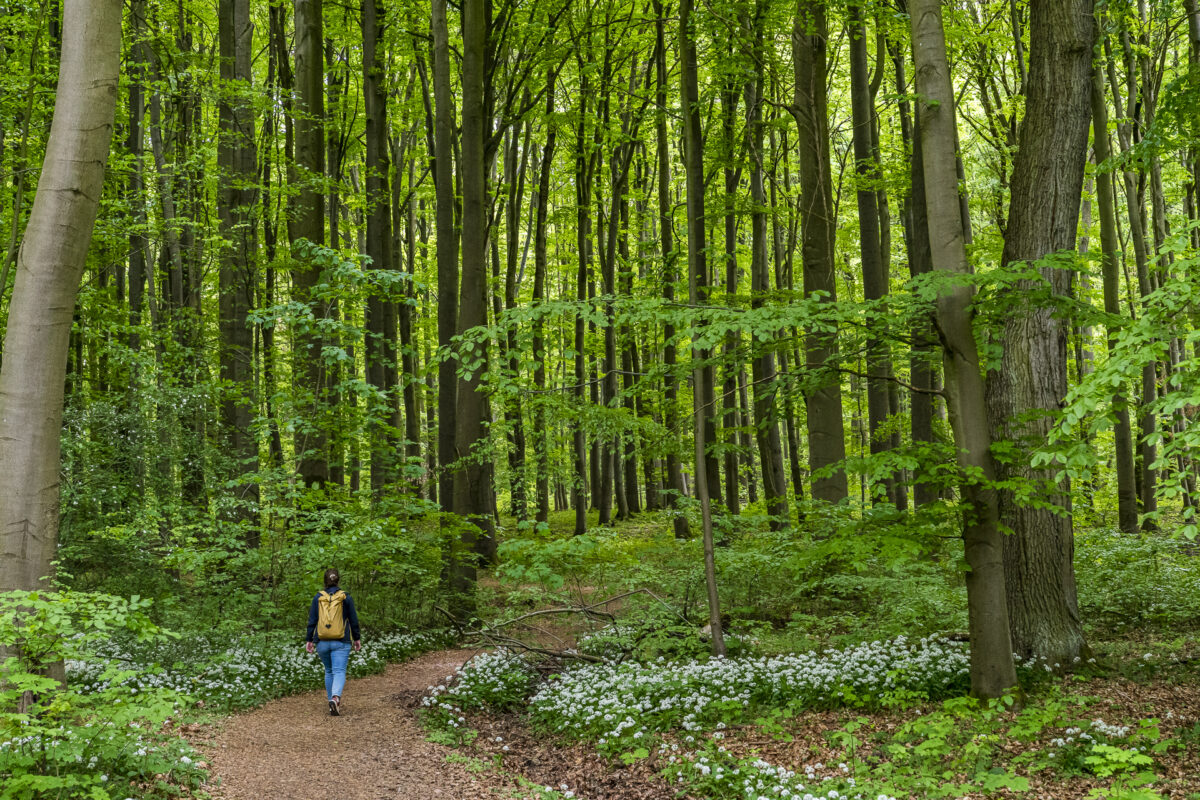

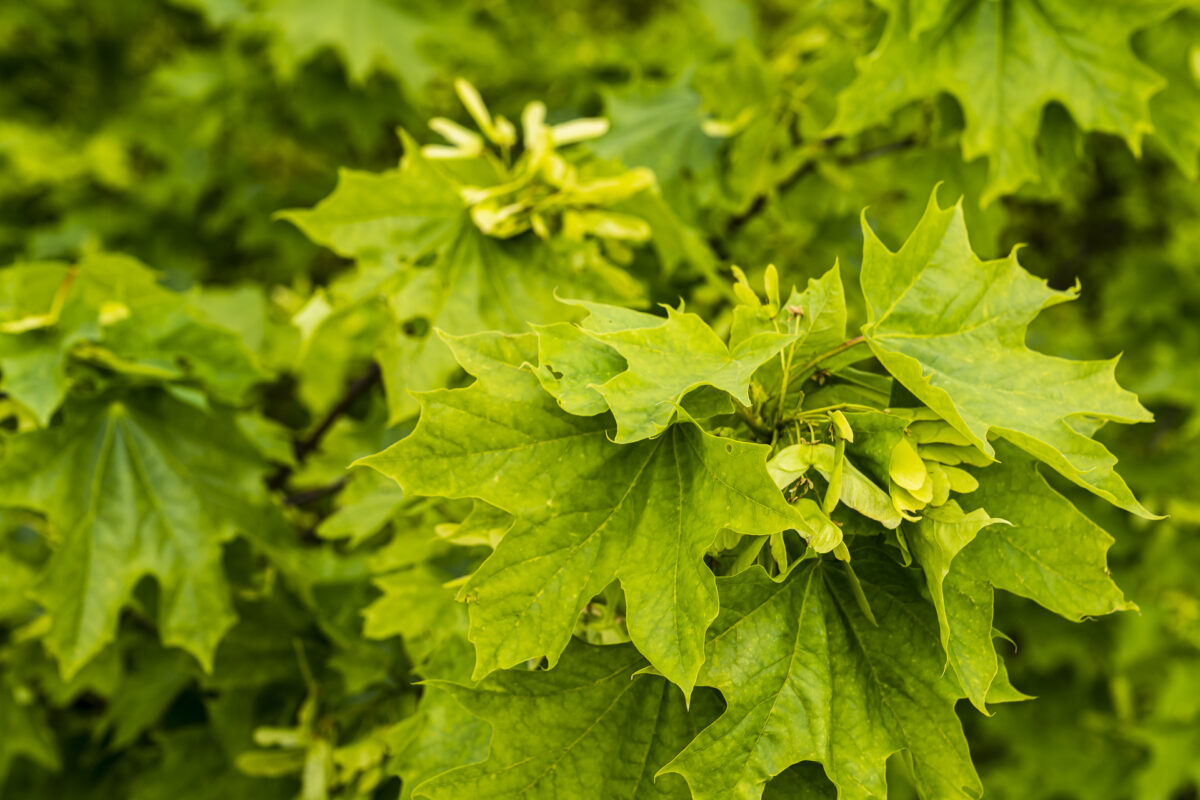
During our visit to Hainich, we just witnessed the wild garlic blossoming. Magical – I’ll tell you. However, the Hainich unfolds its full beauty in autumn, when the deciduous trees shine in all shades of colour between dark red and light yellow.
Practical tips for your trip to Thuringia
- Until the 2023/2024 timetable change in December of this year, Erfurt can be reached directly by train from Zurich several times a day. An ideal opportunity to consider Thuringia as a destination for a long weekend.
- While the cities are well connected to the rail network, the accessibility of the rural excursion destinations (including Hainich) is less ideal. We were therefore on site with a rental car.
- A trip to Thuringia is worthwhile at any time of the year. Spring/early summer (May/June) and autumn (September/October) are particularly recommended.
- I would recommend a time budget of at least three – even more ideally four days – for a trip to Thuringia. Erfurt can be easily visited in one day. In Weimar, one day is not enough to visit all the museums.
- In addition to the UNESCO World Heritage Sites presented in this article, there are other exciting residential cities to discover in Thuringia in addition to Arnstadt; including Gotha and Meiningen.
- More information and inspiration can be found on the official website of Thuringia Tourism: Discover Thuringia


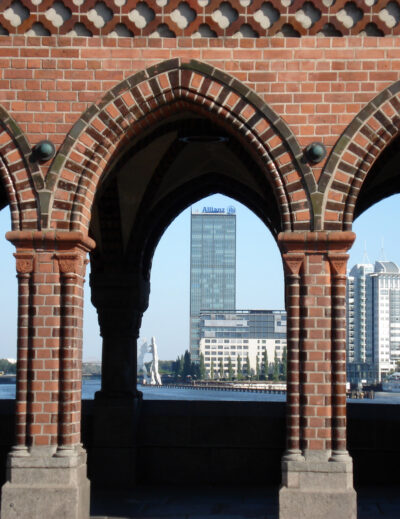

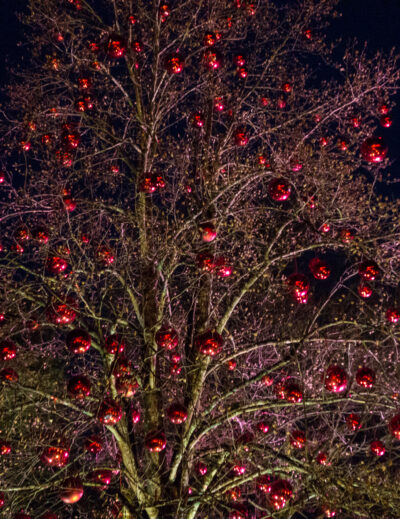
Leave a Reply